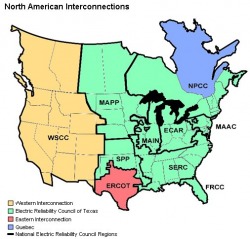Merchant Transmission

Figure 1
North America's electrical power delivery infrastructure includes a network of long-distance transmission lines that move electricity from generators to local distribution systems. Traditionally, local utilities owned and controlled the electrical transmission network. But today, as competition is being forced upon the power industry, ownership and control is shifting on a global basis. Networks are being privatized, ownership is consolidating and control of the transmission network is shifting away from generators. These changes are creating global opportunities for the development of merchant transmission projects.
The power industry has already undergone considerable changes in the last two decades. These changes affect how the electrical infrastructure operates. Major industry restructuring has separated once vertically integrated electric utilities that supplied generation, transmission and distribution service into distinct entities. “Unbundling” has taken place or is underway in most of the world’s major markets, including the EU countries, Scandinavia, much of South America, Australia, New Zealand and most of North America.
North America does not have a single transmission grid. Instead, there are four integrated transmission grids: the Western Interconnection, Eastern Interconnection, Electric Reliability Council of Texas, and the Province of Quebec. These regional grids are international, encompassing the United States, Canada and part of Mexico. Figure 1 shows the four North American interconnections, or grids.
The Western, Eastern and Texas interconnections are not synchronized, thus inhibiting inter-regional power transfers. Special transmission devices are required to allow power to flow between the regions, but few have been installed. As a result, little power flows between the regions.
The interconnections are further broken down into regional and sub-regional areas that are proscribed by the limited capacity of the transmission system to move power between them.
LECTRIX analyzes bottlenecks within the electrical power network and identifies those with significant commercial value. The value of relieving the bottleneck is equal to the added costs imposed upon customers who cannot buy power from lower priced generators. Alternatively stated, the value is equal to the arbitrage opportunity between the non-connected or constrained markets.
LECTRIX captures a portion of this value by developing a “merchant” project. LECTRIX determines what improvements to the electrical power network are required to relieve the constraint and structures a transaction that provides a defensible competitive position in the project. A project may be traditional equipment, like poles and wires, or merely tactical positioning. LECTRIX then seeks regulatory approval to charge market based or “merchant” rates. LECTRIX refers to this process as the development of a “merchant” transmission project.
The power industry has already undergone considerable changes in the last two decades. These changes affect how the electrical infrastructure operates. Major industry restructuring has separated once vertically integrated electric utilities that supplied generation, transmission and distribution service into distinct entities. “Unbundling” has taken place or is underway in most of the world’s major markets, including the EU countries, Scandinavia, much of South America, Australia, New Zealand and most of North America.
North America does not have a single transmission grid. Instead, there are four integrated transmission grids: the Western Interconnection, Eastern Interconnection, Electric Reliability Council of Texas, and the Province of Quebec. These regional grids are international, encompassing the United States, Canada and part of Mexico. Figure 1 shows the four North American interconnections, or grids.
The Western, Eastern and Texas interconnections are not synchronized, thus inhibiting inter-regional power transfers. Special transmission devices are required to allow power to flow between the regions, but few have been installed. As a result, little power flows between the regions.
The interconnections are further broken down into regional and sub-regional areas that are proscribed by the limited capacity of the transmission system to move power between them.
LECTRIX analyzes bottlenecks within the electrical power network and identifies those with significant commercial value. The value of relieving the bottleneck is equal to the added costs imposed upon customers who cannot buy power from lower priced generators. Alternatively stated, the value is equal to the arbitrage opportunity between the non-connected or constrained markets.
LECTRIX captures a portion of this value by developing a “merchant” project. LECTRIX determines what improvements to the electrical power network are required to relieve the constraint and structures a transaction that provides a defensible competitive position in the project. A project may be traditional equipment, like poles and wires, or merely tactical positioning. LECTRIX then seeks regulatory approval to charge market based or “merchant” rates. LECTRIX refers to this process as the development of a “merchant” transmission project.
